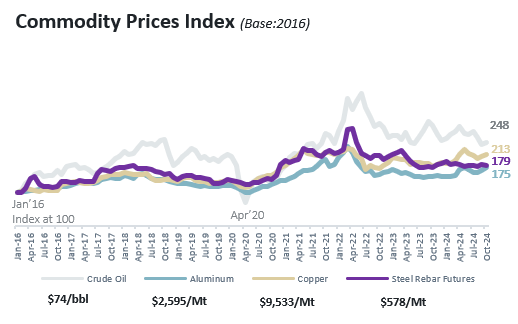IMAP India: Industrials Update November 2024
IMAP’s Industrials group brings you this monthly update with a focus on latest news, transactions and interesting snippets from the Industrials sector in India
Recent News
- EMS company Dixon Technologies, partnered with Taiwanese ODM, Compal Electronics to manufacturer Google Pixel smartphones in India; smartphones currently constitute over 60% of Dixon’s sales
- India’s manufacturing PMI for Nov’24 stood at 57.3; marginally down from 57.5 in the previous month. A figure over 50 symbolizes growth
- U.S. stocks rallied sharply to Trump’s victory with investors expecting lower taxes and deregulation
- Bitcoin prices also reached a all time high of ~US$ 96,675 following a historic bull run in the Crypto market fueled by optimism surrounding potential regulatory ease in the U.S. post-election
- India’s GDP growth fell to a seven-quarter low of 5.4% in Q2, down from 8.1% in the same period last year due to a drop in government spending, excess manufacturing capacity in other regions and weaker domestic consumption
Selection of Recent Transactions
DATE TARGET ACQUISITION
Nov 24 Marut Drones The Agri-drone manufacturer raised $6.2mn in a fundraise led by Lok Capital
Nov 24 E2E Networks L&T acquired a 21% stake in the cloud computing solutions provider for $157.4mn
Nov 24 Vyuti Systems The robotics deep tech startup raised $10mn in a fundraise led Pavestone VC and Athera Ventures
Nov 24 Dream Chip (Germany) The Indian semiconductor chip designer, Tessolve, acquired the German player Dream Chip for $42.5mn
Nov 24 Zepto The quick-commerce unicorn raised $350mn in a fundraise led by Motilal Oswal AMC
Nov 24 DoodhVale The value-added milk product manufacture raised $3mn in a fundraise led by Atomic Capital
India's manufacturing sector performance in the last decade (2014-2024)
A key policy objective of the NDA government since coming to power in 2014 has been to boost India’s manufacturing sector. Its flagship “Make in India” program aimed to create 100 million manufacturing jobs by increasing manufacturing’s share in GDP to 25% by 2022, and to establish India as a global manufacturing hub and drive manufacturing exports.

Thus, despite government support, manufacturing output, employment and exports have at best kept pace with overall economic growth. Some of the possible reasons for this underperformance include the effects of the COVID pandemic, a credit bust and the impact of structural reforms such as GST and the bankruptcy code.
However, green shoots appear visible in the gross fixed capital formation (GCFC) data. GCFC from Mar’14 to Mar’21 grew only at a CAGR of ~3% (at constant prices) as against ~13% in the 2 years since then. The Make in India program is believed to have supported the sector during the period of turmoil, helping it sustain its share of GDP.
A lot more though needs to be done - land and labor reforms at the state level, targeted push in labor intensive sectors, rethinking import tariffs that make exports uncompetitive, investments in skilling and education among others.


